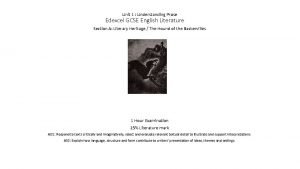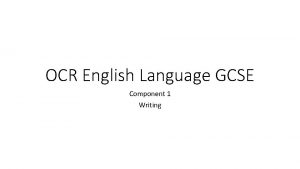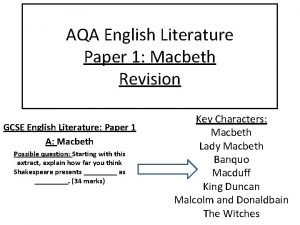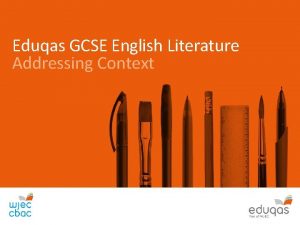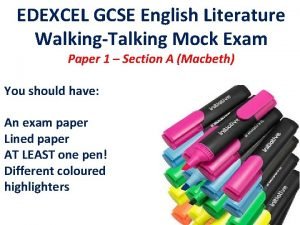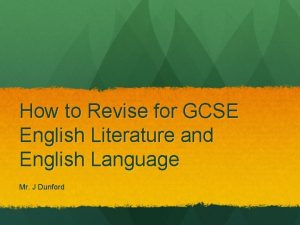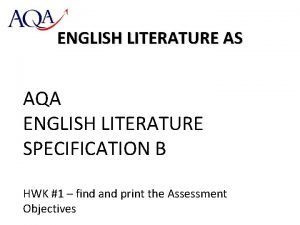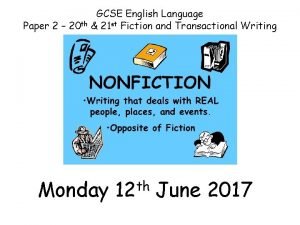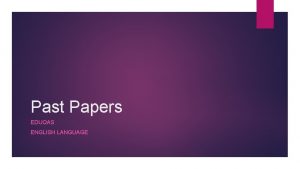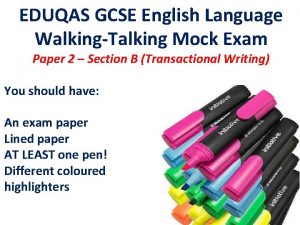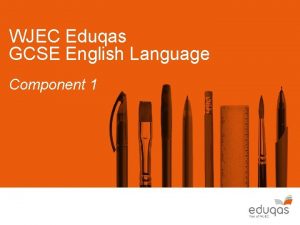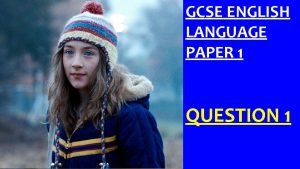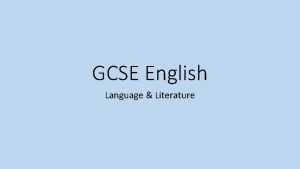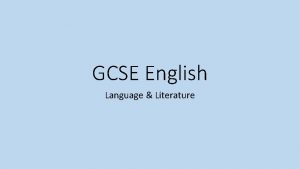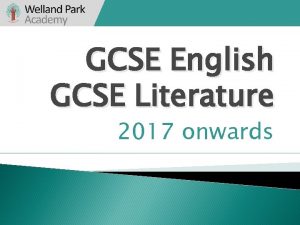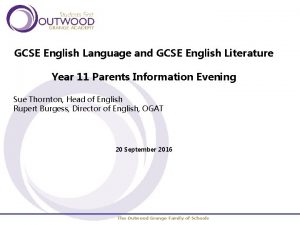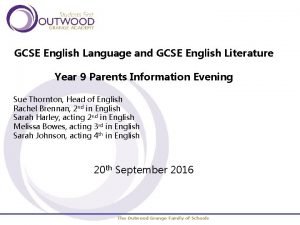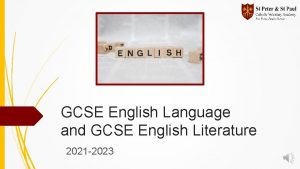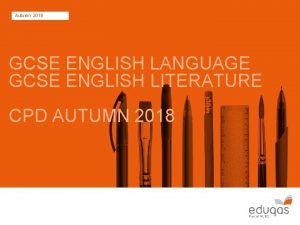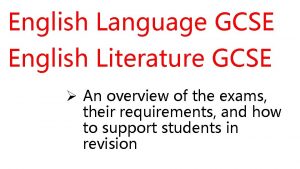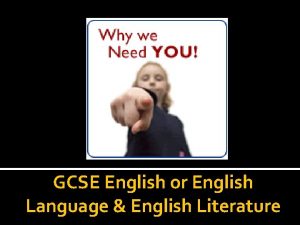GCSE English Language and Literature POETRY and WRITING














- Slides: 14

GCSE English Language and Literature POETRY and WRITING IMAGINATIVELY Theme: Conflict Year 10 preparation for Year 11 In English you are studying for 2 GCSEs: English language and English literature. As part of the literature course we study 15 poems. The activities in this booklet will: 1. help to introduce you to or refresh your memory of the poems (NOTE: you have already studied some of them) 2. give you chance to practice your writing skills for the language papers. Page 1

POETRY and WRITING IMAGINATIVELY Checklist of tasks to do 7 tasks: do one a week through the summer holidays OR one each day over a week OR whenever you like. 1. Descriptive writing – a short piece based on pictures which show various conflicts. 2. Matching the poems’ titles with the most appropriate pictures and summaries after doing some research: google the title of the poem for this and the next task. 3. Timeline: on the right of the line, put information about when the poem was written and on the left, note down any key events of that time relevant to the poem. 4. Matching activity to show understanding of the devices writers use to give their writing greater impact. 5. Matching activity to show ability to find examples of devices used in the poems. 6. Considering different conflicts and reasons for these plus an extended piece of descriptive writing. 7. Research and making notes on a controversial issue in preparation for a piece of writing In September. Page 2 .

TASK 1: Descriptive Writing Write down words that come to mind when you look at these pictures and turn them into a short description. .

• Catrin - TASK 2 a): Research the titles of the poems that we will be studying. Google them. a) Match with the most appropriate picture. b) Sum up what each is about in no more than 20 words. NEED HELP? There are summaries of each on page 7 which you can match with the correct title if you wish • Belfast Confetti • The Prelude • The Class Game • The Charge of the Light Brigade • Exposure • Half Caste • Cousin Kate • Poppies • War Photographer • A Poison Tree • No Problem • Destruction of Sennacherib – • The Man He Killed • What were they like? • Page 4

Picture Quiz: Name the Poem Page 5

Page 6

Task 2 b) Summaries of the poems to match with the titles when you have found out about each one This is about a group of soldiers who were sent into battle although it was dangerous and most were slaughtered but they were portrayed as heroes. This describes someone being caught up in a bomb blast during the conflict in Ireland trying to escape. This shows what it was like on the front line in the First World War and how there was a lot of waiting around and how the cold weather was as dangerous as fighting. This challenges the labels that are used to describe black people. This is about a mother remembering her son who became a soldier and died in battle. This is about the Vietnam War and how the country and its culture was destroyed by the war. This poem explores how destructive anger can be if it’s allowed to grow. This considers how an enemy soldier is just an ordinary person like you or I who, if there wasn’t a war, you might get on with. The poem is about a woman, who is seduced by a powerful lord and gets pregnant. She has the baby but he doesn’t marry her (thought wrong in those days). Instead he marries her cousin. This is about a relationship between a mother and daughter and their strong bond but also their conflicts. This looks at the experience of a war photographer taking and developing photos of suffering during war and feeling the rest of the world isn’t really interested. This poem explores the poet’s personal struggles with racism and stereotyping. This describes the poet stealing a boat to go out on the lake at night and loving the natural world and peace found there. This considers how we make judgements about people by looking at them and deciding their background. This retells a biblical story in which God sends an Angel to destroy the Assyrian army that is about to lay siege to the holy city of Jerusalem. It reflects on how powerful God is. Page 7

8 Task 3 : The context of the poems (when they were written ) Page On the right of the timeline below from 1800 to 2020 write down the poems in the order they were written (date published) EXTENSION ACTIVITY: To the left name any event(s) which might have influenced what the poem is about. 1800 1810 1820 1830 1840 1850 1860 1870 1880 1890 1900 1910 1920 1930 1940 1950 1960 1970 1980 1990 2000 2010 2020

Task 4: Page 9 Match the poetic devices to the descriptions Tone Hyperbole Emotive words Metaphor Onomatopoeia Imagery . When sentences run into the next line with no punctuation or pause between them. The repetition of one or more initial letters. When two or more words have the same sound at the end of a sentence. When a sentence or phrase is repeated. A poet does this for effect. The organisation of a poem including how many stanzas it has. Simile Theme Personification Enjambment Alliteration Rhyme Repetition Structure The emotion that the author is feeling as they write. Extreme exaggeration. Words that create an emotion. A figure of speech that compares unlike objects. The use of words whose sounds suggest their meaning. Creates a picture in your mind. A comparison usually using the words ‘like’ or ‘as’. The central idea of the poem; what it is about. When animals or objects are said to have human characteristics.

TASK 5 : Page 10 Write down examples of the devices in the third column below using lines taken from the poems you will be studying. These are on the next page. Emotive words . Words that create an emotion. Hyperbole Extreme exaggeration Metaphor A comparison of one object with another to capture something specific about what is being described Onomatopoeia The use of words whose sounds suggest their meaning. Imagery Simile Words which create a picture in your mind. A comparison using the words ‘like’ or ‘as’. Personification When animals or objects are said to have human characteristics. Alliteration The repetition of the first one or two letters in more than one word in a sentence. When two or more words have the same sound at the end of a sentence. When a sentence or phrase is repeated. Rhyme Repetition

Lines from the poems you will be studying. Use these for task 2 to fit in column 3. The full poems can be found in the Poetry Anthology p. 24 – 40. “And I sunned it with smiles, And with soft deceitful wiles”. (from “The Poison Tree” by Blake p. 24) “The Assyrian came down like the wolf on the fold” (from “The Destruction of Sennacherib” by Byron p. 25) “A huge peak, black and huge… towered up between me and the stars, and still, For so it seemed, with purpose of its own like a living thing, Strode after me” (from “The Prelude” by Wordsworth p. 26) ‘Yes; quaint and curious war is! You shoot a fellow down You’d treat if met where any bar is, Or help to half-a-crown. ’ (from “A man he killed” by Hardy p. 27) “He lured me to his palace-home – His plaything and his love. He wore me like a golden knot, He changed me like a glove” (from “Cousin Kate” by Rossetti p. 28) “Explain yuself wha yu mean when you say half-caste yu mean when picasso mix red an green is a half-caste canvas explain yuself wha yu mean when yu say half-caste “ (from Half Caste” by Agard p. 29) “Dawn massing in the east her melancholy army Attacks once more in ranks on shivering ranks of grey” (from Owen’s “Exposure” p. 30) Page 11

More lines from the poems you will be studying. Use these for task 2 to fit in column 3. “Their’s not to reason why, Their’s but to do and die: Into the valley of Death Rode the six hundred “ (from Tennyson’s “Charge of the Light Brigade” p. 32) “I can remember you, our first Fierce confrontation, the tight Red rope of love which we both Fought over” (from “Catrin” by Clarke p. 34) “ At the corner, the first bomb of the morning shattered the stones. Instinct prevailing, she dropped her burden and, mouth too small for her dark scream, began to run. ” (from “War Photographer”” by Satyamurti p. 35) “ Suddenly as the riot squad moved in, it was raining exclamation marks, Nuts, bolts, nails, car-keys. A fount of broken type. And the explosion “ (from “Belfast Confetti” by Carson p. 36) “Have I a label on me head, and another on me bum? Or is it because my hands are stained with toil? Instead of soft lily-white with perfume and oil? Don’t I crook me little finger when I drink me tea? Say toilet instead of bog when I want to pee? “ (from The Class Game by Casey p. 37) “I am “skirting the church yard walls, my stomach busy making tucks, darts, pleats, hat-less, without a winter coat or reinforcements of scarf, gloves. ” (from “Poppies” by Weir p. 38) “Black is not de problem Mother country get it right An juss fe de record, Sum of me best friends are white”. (from “No Problem” by Zephaniah p. 39) Question: “ 3) Were they inclined to quiet laughter? Answer: 3) Sir, laughter is bitter to the burned mouth”. (from “What were they like? ” by Levertov p. 40) Page 12

• 1. What is conflict? • 2. What types of conflict are there? • 3. What things can cause conflict? TASK 6: All of the poems that we will study are linked by theme of conflict. Answer the questions then do the descriptive writing. • 4. How can conflicts be resolved? • 5. Think about a time you have been in conflict (it might be with another person or a conflict with yourself. Write down a list of adjectives habout how you felt during this time. • 6. Write no more than 200 words explaining your conflict. What happened leading up to it? Who was involved? What happened during it? How was it resolved, or wasn’t it and why? Try to capture every detail and changing feelings. NOTE: a) Use paragraphs. b) Use as many devices listed on page 2 as you can. c) Check SPa. G.

TASK 7: Research an issue and make notes to use in a piece of writing in school in September Possible issues: some linked with the book we looked at – “Where the crawdads sing, ” others with current issues of concern, some linking with both Sexism – could link to Me 2 Racism – could link to George Floyd and Black Lives Matter Discrimination Bullying Inequality Poverty The Environment could link with global warming Capital Punishment Coronavirus NOTE> You could google Ted Talks and search for a subject of interest to listen to.
 Gcse english literature paper 1 edexcel
Gcse english literature paper 1 edexcel Edexcel gcse english literature
Edexcel gcse english literature Gcse speech example
Gcse speech example Aqa english literature paper 1 macbeth
Aqa english literature paper 1 macbeth Eduqas poetry anthology
Eduqas poetry anthology Macbeth edexcel questions
Macbeth edexcel questions How to revise for english literature gcse
How to revise for english literature gcse Aqa gcse english literature specification
Aqa gcse english literature specification English language paper 2 edexcel
English language paper 2 edexcel Pearson gcse english language
Pearson gcse english language Edexcel gcse english language paper 2
Edexcel gcse english language paper 2 Eduqas english language component 2 past papers
Eduqas english language component 2 past papers Eduqas gcse english language past papers
Eduqas gcse english language past papers Eduqas gcse english language
Eduqas gcse english language The lovely bones language paper 1 answers
The lovely bones language paper 1 answers

